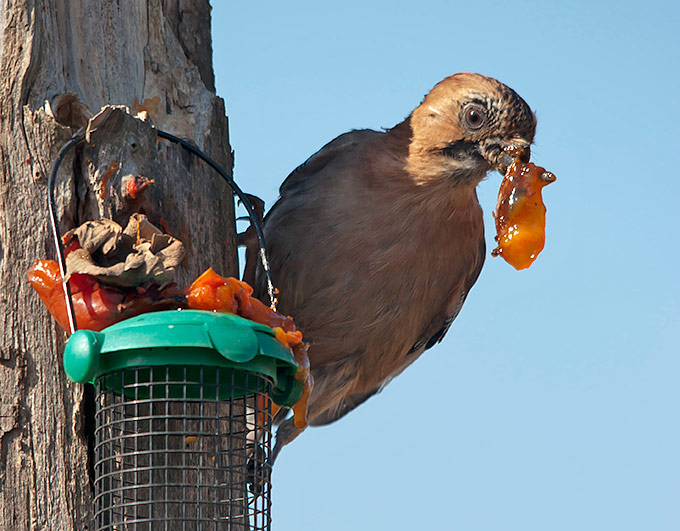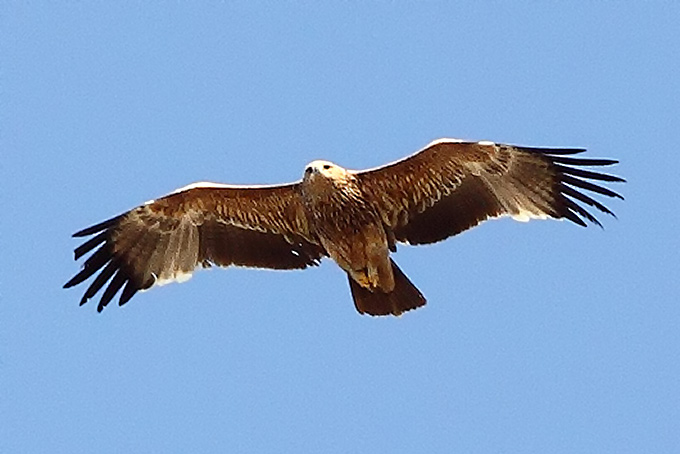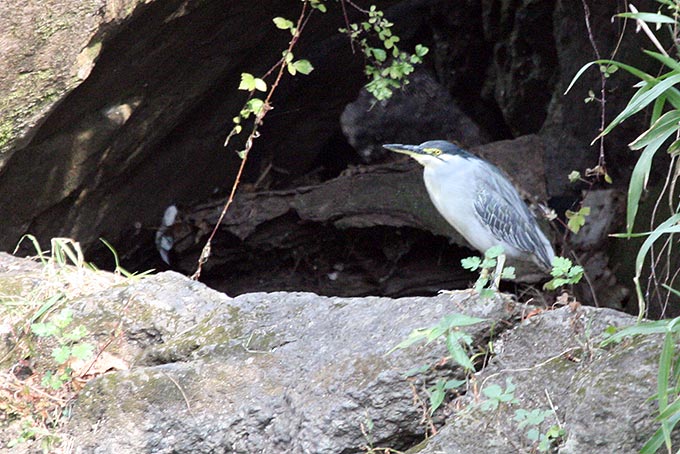 | E-mail to Birds Korea |
 | KWBS |
in the Region
 | The Oriental Bird Club |
 | BirdLife International (Asia) |
November
Waves of colder air cause a sharp drop in temperature, especially from mid-month onwards, when maxima can be as low as 8-10°C: the last of the autumn migrants are joined by huge numbers of wintering waterbirds.
Numbers of Baikal Teal continue to build, along with geese (many of which move on into China). Swan Geese peak at the Han-Imjin (with 1000-1500 in recent autumns). Common Buzzards and Cinereous Vultures start to arrive for the winter, along with gulls (Saunders’s, Heuglin’s, Vega, Mongolian and Slaty-backed are all widespread), Red-crowned, White-naped and Hooded Cranes, and passerines, including Siberian Accentor. Movements of pers and alcids, most especially Ancient Murrelet, can be impressive. Passerines include many late summer visitors until the second week of the month, when winter species, such as Chinese Penduline Tit and Pallas’s Reed Bunting start to predominate.
In recent years November has produced national rarities such as Red Phalarope, Iceland Gull and the country’s third and fourth Verditer Flycatchers in 2004. National firsts in November include White-capped Water Redstart in 2003 and Redwing in 2006.
(The following records are a compilation of our own sightings and records sent in by other observers. As well as being posted on the Birds Korea website(s), selected records are also forwarded to other Korean-language birding websites; records of threatened species are arranged and forwarded to Birdlife International and national authorities when appropriate; flag images and records are passed to bodies responsible for their coordination throughout the flyway; and all records sent to us are used to compile annual reports and to support the evolving understanding of the status of many of Korea’s birds.)
Suncheon Bay, November 30
The five hours I spent at Suncheon Bay Eco-Park were very enjoyable. Despite large flows of human traffic along the reed walkways, I could still find Common Reed Buntings and Pallas' Reed Buntings there. A walk along the unpopulated west bank of the river revealed that all the Hooded Cranes I had seen flying out to the mudflats at about 12.30 were busy feeding there, at least 150 of them, together with about 50 Whooper Swans and one Eurasian Spoonbill. At this point I could not resist taking the 30-minute river cruise, and I was not disappointed. I saw the cranes from much closer (though the boatman was careful not to disturb them), as well as Northern Lapwings, a Marsh Sandpiper, Dunlin and Grey Plover, an Eurasian Curlew, a Hen Harrier and Black-headed Gulls, a Taimyr Gull and a Saunders’s Gull. At about 3 pm the hooded cranes returned to the rice fields and hob-nobbed noisily. After visiting the excellent Museum, I headed home, determined to pay another visit soon.












Junam Reservoir, November 26, 27 & 28
The undoubted highlight of a productive weekend at Junam was the large eagle located by DLC during the late morning of 26th. Initially identified as either a juvenile Steppe or juvenile Eastern Imperial Eagle, the bird unfortunately drifted far away before it could be conclusively identified. The following afternoon, DLC located the bird again over rice fields at the far northern end of the reservoir, when better (albeit briefer) views, coupled with better knowledge of ID criteria, permitted identification as a juvenile Eastern Imperial Eagle. We also had the trump card of some images hurriedly taken by Lee Seok Gu on 26th, images which later turned out to be excellent and confirmed the identification (see attached). The bird was not seen on 28th despite searching, although there must surely be a possibility that it might overwinter in the area.
Other raptors in evidence in the clear sunny conditions of 26th were 2 Cinereous Vultures heading northwest over the reservoir, an adult White-tailed Eagle, 3 different Peregrines including a juvenile bird chasing Greater White-fronted Geese, and 2 Common Buzzards. The adult White-tailed Eagle was seen again on 27th although it was not seen on 28th, perhaps due to a large amount of human disturbance around the reservoir owing to a festival taking place there. On 27th and 28th, a female Merlin was hunting around the rice paddies north of the reservoir, clearly targeting the wintering flock of Buff-bellied Pipits in that area - at one point we were treated to a spectacular chase which culminated in the pipit's demise.
Raptors aside, White-naped Cranes have returned to winter at the reservoir with a high count of 34 on 28th. 2 Swan Geese were seen on 26th, with 700 Baikal Teal on the same date and perhaps 900 at dusk on 28th. On the water, about 90 Smew were joined on 27th by two drake Common Goldeneye. Other notable water birds included 2 Little Grebes and 4 Great Crested Grebes on 27th, a peak count of 18 Eurasian Spoonbills, and 210 Whooper Swans counted on 27th.
Away from the water, modest highlights included 2 Dusky Thrushes and a Grey-headed Woodpecker. Perhaps best of all was a non-avian wintering species: a fine Amur Leopard Cat on the road near the viewing tower on 26th.



Jeju island, November 27
At the base of remote grassy cliffs on Jeju's west coast, two Rosy Finch were spotted when they braved extremely strong winds and came down to drink trickling fresh water. Earlier in the day, Young Ho saw about 30 Rosy Finch in the same spot, and last week one of Young Ho's friends saw as many as 180 Rosy Finch on these cliffs. At Yongsu, 2 Bean Goose, a dozen Coot, and about 150 Spot-billed Duck and Mallard. Along the west coast, several Little Grebe, Common Sandpiper, 5 Pintail, 50 more Spot-billed Ducks, as well as an Osprey and a Peregrine Falcon.
After parting ways with Young Ho, I spotted several Olive-backed Pipit, a dozen Hawfinch, and several Pale Thrush in a hilltop park in Seogwipo. In another park, a Striated Heron has been seen in the same spot on a small river for the third winter in a row. Also in the park was a female Pintail, two dozen Mandarin Ducks, and a circling Goshawk.







Marado Island of Jeju, November 27
A female Fujian Niltava Niltava davidi, was found in Marado Island of Jeju Province, South Korea on 13th November, 2010. This is the first record in South Korea. The bird was found during the research conducted together by the Jeju Wildlife Research Center and the National Institute of Biological Resources (NIBR).
Fujian Niltava is a residential bird species in south China and Northern South-east Asia. In this region, it has restricted range in montane Fujian. And it was only accidentally found in northeast to Hebei. Some population migrates to Thailand and Indochina for wintering. So, it has not been found even in Taiwan or in Japan.
Regarding that they mostly favor dense broadleaf evergreen forest undergrowth (Mark Brazil), it is surprising that it was found in Korea, far away from their region, south China.

Eulsukdo, November 23
The weather told me the day was not for wasting, so off to Eulsukdo it had to be. I arrived at the bird watching platform just as the tide was going out, exposing the mudflats. This happened to be feeding time for the masses of Mallard and Northern Pintails. My expectations were greatly enhanced when a pair of Black-faced Spoonbills breezed in. However, they stayed for less than a minute. After that everything was a bit of an anti-climax, though I saw lots of birds, including three Whimbrels, a Common Goldeneye, Little and Great Crested Grebes - not to forget the resident Kestrel.






Junam Reservoir, November 22
The constantly changing bird populations at Junam over the last few weeks have been fascinating. Whereas early in November, the reservoir was carpeted with Falcated Duck, today virtually none were seen. The hundreds of Baikal Teal observed in early November were also completely absent today. In their place, around 40 Smew brightened up the waters of the reservoir. A lone juvenile White-naped Crane on the emerging mud spit was joined by 8 more as evening approached (4 more juveniles and 4 adults). Eurasian Spoonbills (14) were also newly arrived winterers since my last visit. Black-tailed Gulls (10) loafed near the mud spit at dusk, when the arrival of flocks of Greater White-fronted Geese and Taiga Bean Geese was nothing short of spectacular. Among 50 or so Whooper Swans on the reservoir, an individual with an orange neck ring numbered "F18" was noteworthy. Near the bus stop, 6 White-cheeked Starlings hawked insects from wires in the mild, calm conditions, while 2 Dusky Thrushes nearby were a sign of the approaching winter. A Hoopoe was also seen today.
Seogwipo, Jeju Island, November 16
A crisp sunny day for a walk through my patch of parks in Seogwipo. The first few Jeju winter specials were spotted in a riverside park - several furtive Pale Thrush, a foraging Red-flanked Bluetail, several Japanese Bush Warblers, a Grey Wagtail, and numerous Japanese White-eyes were seen. On the river, about 25 Mandarin Ducks mingled with a like number of Spot-billed Ducks and 6 Little Grebes in winter plumage, while a smartly-marked Eurasian Magpie scolded me from a nearby tree. Also in this park were several Great Tits, a Daurian Redstart, and a White-backed Woodpecker.
A Chinese Pond Heron crept through a nearby field. This is the second Chinese Pond Heron in winter plumage I've seen on Jeju in the past 2 years - perhaps they're expanding their winter range northwards?






Upo Wetland, November 16
A leisurely walk around Upo lake and I saw great numbers of Mallard, Eurasian Teal and Taiga Bean Geese along with lesser numbers of Gadwall, Common Pochard, Northern Pintail and Northern Shoveler. Also seen were two Heuglin's Gulls, a lone Northern Lapwing, a family (2 adults, 2 juveniles) of Tundra Swans, a Peregrine Falcon and, best of all, two pairs of Eurasian Spoonbill. I also got a clear brief view of a young Water Deer, before it hunkered down in long grass.




Junam Reservoir, November 9
A cold west wind was blowing as I paid my first ever visit to Junam. I arrived in mid-morning just as a breathtaking flock of 16 noisy White-naped Cranes flew over. About 2 and a half hours later I found 13 foraging among rice stubble, including 4 juveniles. Apart from this, I saw nothing that has not been well reported here recently. Of course there were plenty of great birds to see, and I counted 50 Whooper Swans on the lake in front of the watchtower.




Junam Reservoir, November 6
A ringtail Hen Harrier today was the 10th species of raptor I have seen at Junam over my last 5 visits (the others being Western Osprey, Oriental Honey Buzzard, Common Buzzard, Northern Goshawk, Eurasian Sparrowhawk, Peregrine, Eurasian Hobby, Merlin and Common Kestrel). Also of note, a Whooper Swan wearing a red neck band was present, but unfortunately it was too distant to read any of the numbers on the band. New in since my last visit was a Great Crested Grebe and 8 Northern Lapwings. Otherwise it was quiet, with the usual range of species present in good numbers including probably several thousand Baikal Teal hunkered down among the remains of the floating vegetation.
Northeast Gangwon Province, November 2
It's been a while since I contributed to the Birds Korea website with news of birds from Gangwon Province. I've been birding but haven't had time to report on the birds I've seen during the autumn migration along the east coast of Korea.
Late August and early September was a good time to see shorebirds along the coast and in coastal streams. October saw the return of some waterbirds as the cooler weather returned. Mandarin Ducks formed flocks in mid October before departing from this part of Korea for winter. On October 24 I saw numerous Sparrowhawks heading south along the coast near Ganseong. Mallards, Tufted Ducks, Greater Scaups, Eurasian Coots and Great Crested Grebes were seen in significant numbers in freshwater habitats. There were smaller numbers of Littel Grebes, Northern Shovelers, Northern Pintails and Pochards. Ospreys have been around for a month or so.
On October 30 I did a survey of birds along Namdae Cheon near Yangyang. On the sea near the sandbar were 700+ Cormorants, as well as a few Red-breasted Mergansers and Great Crested Grebes. The birds on the sandbar were disturbed by a recreational fisherman. In the freshwater I saw over 600 Mallards. There were also Spot-billed Ducks, Common Teal, Coots, Greater Scaups, Pochards, Little Grebes, 2 Black-necked Grebes, Northern Pintails and 3 Baikal Teal. Closer to Yangyang near the road along the river I found a Common Starling in spotty winter plumage and 6 Amur Falcons. The falcons were perched on an overhead cable and were dropping down to the ground to catch grasshoppers in the grass.
October 31 I drove around Hwajinpo Lagoon and up to Daejin harbour in the rain. There were large numbers of Greater Scaups, Tufted Ducks and Mallards on the lagoon, with some Coots, Little Grebes, Great Crested Grebes, Bean Geese, Pochards, Spot-billed Ducks, an Osprey and a couple of Black-headed Gulls. Around Daejin there were lots of Vega Gulls and Black-tailed Gulls. On the rocks in Daejin Harbour there were some Temminck's Cormorants and a Pelagic Cormorant. On the hillside behind the harbour was a flock of Azure-winged Magpies.







Majin-ri, Gyeongsangnamdo, November 2
An afternoon trip along our local Namgang riverbanks and many birds were about. I saw small flocks of Yellow-throated Buntings, Varied and Long-tailed Tits and a couple of Marsh Tits. By the cliffs raptors were quite frequent, including a Eurasian Sparrowhawk, a Northern Goshawk and two Eastern Buzzards. Then I was delighted to see a Western Osprey flying over carrying a large river fish which it took up into the mountains to devour.









